
Sunscapes and Moonlight
A sunrise over Scott Base looking east out over the vehicle hitching rail from the main side entrance of Scott Base. It's 8.30 am and only 2 weeks to go before the sun doesn't make it over the horizon line any more. As the days go by, the sunrise moves further north behind the bulk of Eribus and is soon lost to all at Scott Base.


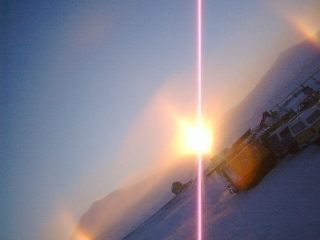
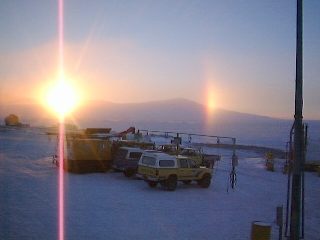
Above are the pictures that I really like. These
were taken just outside the carpenter's workshop (of Scott Base)
at about 9.30 am in late March of 1998. This is no camera
trickery; what you see is only partially as good as what it
looked like in true life. The ice crystals in the air and the
angle of the sun cause the double sun dog effect. I had to turn
the camera on an angle to get both the sun dogs at once. It
really was impressive to see, and it only lasted about 10 minutes.
The sun has only just peaked over the low lying saddle between
Eribus and its foot hills and it quickly disappears again as it
moves around the horizon to the left without gaining any further
height. The strong pink line going through the picture is a
characteristic of the digital camera in strong light.
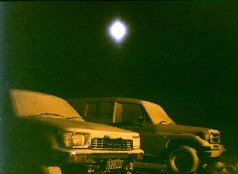
A little bit of moon light over the winterized vehicles.
The atmosphere around Antarctica is so clear that objects far
away can seem very close. Often you can make out many of the
moons surface details with the naked eye.
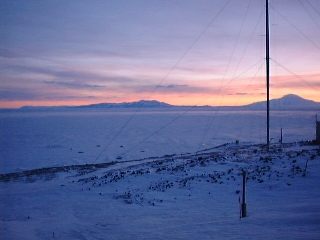 Looking to the South West from around the Hatherton Lab, you can
see the fading colors of an Antarctic winter evening sky. Beside
the radio transmit mast is Mt Discovery and in the range of hills
to the center left of the picture is Mt Aurora (which we have
climbed) .
Looking to the South West from around the Hatherton Lab, you can
see the fading colors of an Antarctic winter evening sky. Beside
the radio transmit mast is Mt Discovery and in the range of hills
to the center left of the picture is Mt Aurora (which we have
climbed) .
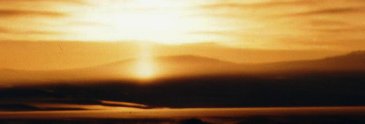
I went outside one day and say this rod of light
breaking through the clouds and exploding onto the side of the
hills around Mt Eribus. The camera obviously had trouble
focusing on something so bright but it gives the general idea,
even if it did turn out a bit yellow and out of focus.
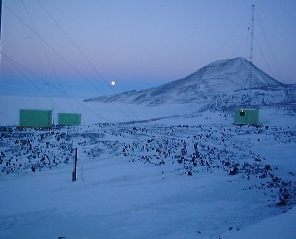 Looking out from one of the
emergency escape doors in the link way outside the Hatherton lab.
The moon does a wobbling dance around the horizon and never seems
to set where you think it should. Observation Hill is a popular
attraction for the locals of Scott Base and McMurdo. During the
night it gets a strange pink luminescent glow (only just visible
)on the North facing (to the right) as the lights from Mactown
reflect off the snow-covered face.
Looking out from one of the
emergency escape doors in the link way outside the Hatherton lab.
The moon does a wobbling dance around the horizon and never seems
to set where you think it should. Observation Hill is a popular
attraction for the locals of Scott Base and McMurdo. During the
night it gets a strange pink luminescent glow (only just visible
)on the North facing (to the right) as the lights from Mactown
reflect off the snow-covered face.
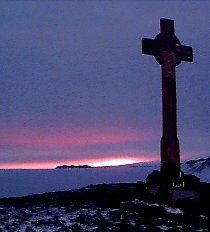 Vinces
cross which is in so many photos (like Eribus) once again becomes
the focus and setting for another memory of the antarctic
twilight. Many people don't get to see these scene's as it
is very cold and more than just a minor hassle to make the effort
and get outside to take photos or just enjoy the moment.
Even though it looks very peaceful its very difficult to feel
relaxed as the wind is blowing a steady 15 knots and the
temperature before wind-chill is about -40. Your camera is
carefully tucked inside your jacket and you wonder if its going
to freeze up before taking the photos you want.
Vinces
cross which is in so many photos (like Eribus) once again becomes
the focus and setting for another memory of the antarctic
twilight. Many people don't get to see these scene's as it
is very cold and more than just a minor hassle to make the effort
and get outside to take photos or just enjoy the moment.
Even though it looks very peaceful its very difficult to feel
relaxed as the wind is blowing a steady 15 knots and the
temperature before wind-chill is about -40. Your camera is
carefully tucked inside your jacket and you wonder if its going
to freeze up before taking the photos you want.
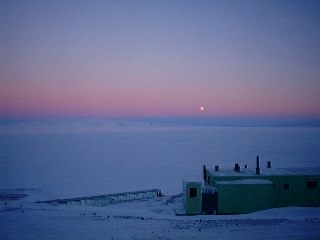 Looking south from the Scott Base dining room out over the old
Trans-Antarctic Exploration hut. The moon continues its wobble
around the horizon, and is eventually trying to set between White
and Black Islands.
Looking south from the Scott Base dining room out over the old
Trans-Antarctic Exploration hut. The moon continues its wobble
around the horizon, and is eventually trying to set between White
and Black Islands.
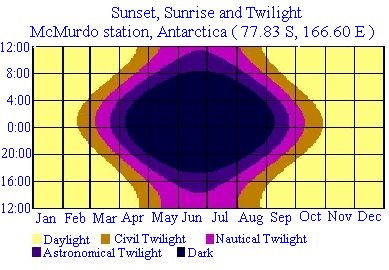
This graph is found on the internet and indicates the sunset, sunrise and twilight of McMurdo Station. Not 100 percent accurate for Scott Base residents but it gives a good idea. The final sunset for this area was on the 24-4-98. Twilight continues for a few weeks but we will lose even that luxury after a while.
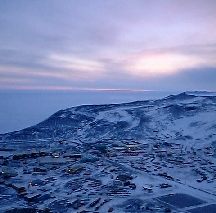 This photo was taken by Eric from
Observation Hill at 1 pm on 25-4-98, the day after the last
sunrise before winter. It looks north over Mactown and even
though you may see a glow in the sky, it is just the sun
illuminating the clouds from below the visible horizon.
This photo was taken by Eric from
Observation Hill at 1 pm on 25-4-98, the day after the last
sunrise before winter. It looks north over Mactown and even
though you may see a glow in the sky, it is just the sun
illuminating the clouds from below the visible horizon.
Below are sunsets & sunrises from previous years. I don't know when, but it looks like they have been taken from around the Scott Base area. The days of late autumn and early spring in Antarctica give some spectacular sky paintings of light and color. You just have to be in the right place at the right time with camera in hand. Most times I don't have a camera on me and all I can do is relax and enjoy the serenity while trying to remember every detail, like a snap shot for the mind. I remember one day I was out running up the hill at the back of Scott Base and the sky turned into an amazing patchwork quilt of deep purples, blues and violets. I stopped and just stared for a while before I had to start running again to keep from freezing. Nobody else had seen it from inside the base but I will never forget it. Photography doesn't always catch the feelings of the moment, but it can jolt back into life the emotions of those who were there when it was taken. Imagine what the person was thinking at the time of these pictures.
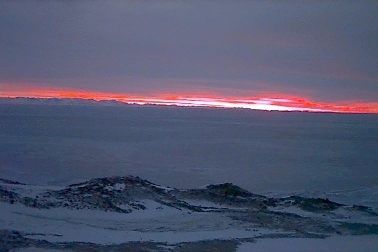
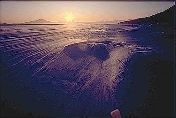
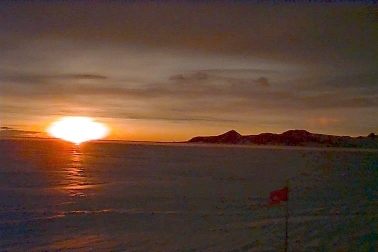
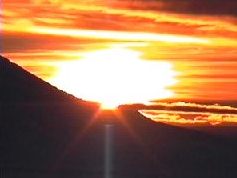
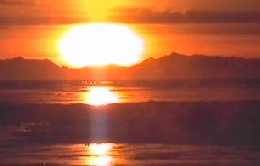
The sun skirting the horizon at Cape Bird on the other side of Ross Island. Jonathan with his trusty digital video was at Cape Bird at the beginning of the season and took the 2 photos above and the one below not long after.
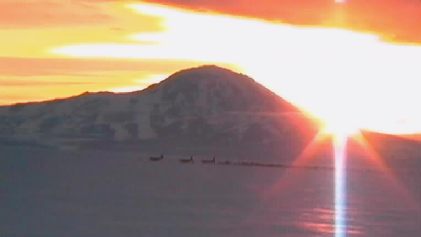
The planes lined up under the shadow of Observation Hill at the sea ice runway. The 24 hour sun drops down to horizon level before reappearing on the other side of the hill and climbing back up into the sky.
www.geocities.com/coolrunnernz/
9-3-01
Edited by Shirley Baston Fred - [email protected] - ICQ #15167279